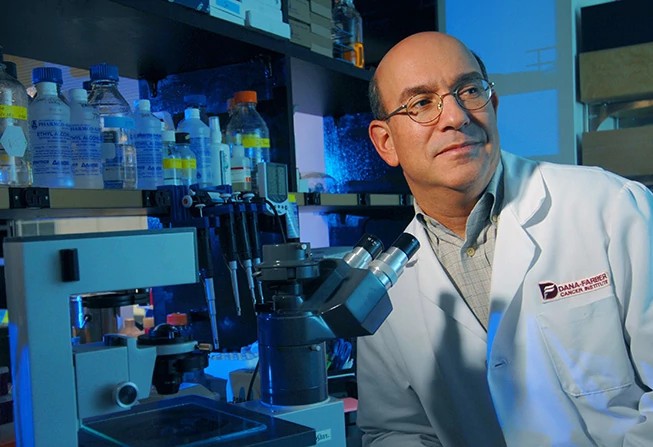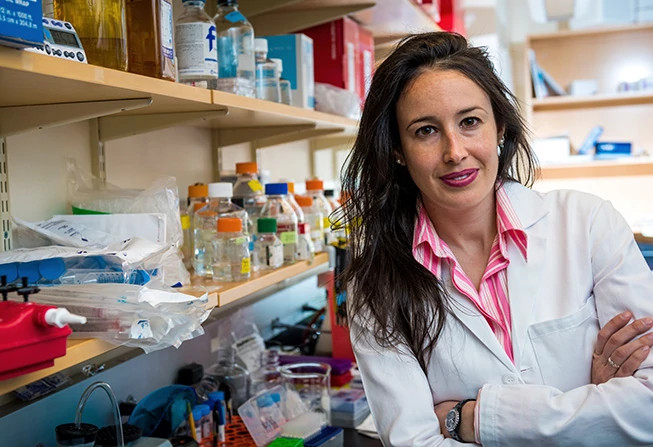Switching Cancer's Signals
The Science of Epigenetics and the Potential for Cancer Treatment
From Paths of Progress 2018
By Robert Levy

Even as cancer cells shake off the normal restraints on their growth, even as they binge on nutrients and barge past their allotted lifespan, they're also undergoing an identity crisis.
A cancer cell is forever betwixt and between. A liver cancer cell, for example, may function in some ways like a normal liver cell and in other ways like an utter misfit in the body's networks of highly disciplined, tightly regulated cells. Having no role beyond its own survival, keeping a low profile to avoid an immune system attack, a cancer cell is destined for life at the margins.
The most common explanation for cancer's rebelliousness is genetic: misaligned chromosomes, misspelled DNA, or miscopied genes all tamper with a cell's basic programming, sending it into hyper-growth. But another kind of alteration is just as characteristic of cancer cells as broken chromosomes and crippled genes. It has nothing to do with the order in which DNA letters are arranged within chromosomes, but in how those letters are read by the cell — how a cell accesses the genetic information it needs to survive, and how it archives information it doesn't immediately require.
The collective name for the processes by which cells designate some genes for use and others for storage is epigenetics. Epigenetics is key to an organism's development. From a single cell, a human embryo must be able to develop muscle cells, nerve cells, kidney cells, and the hundreds of other cell types that comprise a human being. It is the specific set of switched-on genes within a cell that determine the type of cell it is. And it is epigenetic factors that influence which genes are active — which are in use by the cell — and which are not.
"Almost all of the cells of our bodies (except, interestingly, certain immune cells) have exactly the same genes — the same 'hardware,'" says Myles Brown, MD, co-director of Dana-Farber's Center for Functional Cancer Epigenetics and the Emil Frei III distinguished professor of medicine at Harvard Medical School. "It is the specific 'software' that a cell is running that determines its cellular identity. In cancer, both defects in the hardware (gene mutations) and 'bugs' in the software (epigenetic alterations) play major roles."

Mothballing DNA
Epigenetics can be thought of as a cell's filing system for genetic information. Genes that are needed by a cell — for contracting and relaxing, say, in a muscle cell — need to be readily available, while genes not required by that cell must be tucked away. A smartphone may hold hundreds of apps, but even if the user is a master multitasker, only a few are likely to be open at any one time. Cells must achieve something of the same division between their potential abilities and their actual activities.
They accomplish this through the marvel of DNA packaging. Within the cell nucleus, DNA is looped around proteins called histones to form a combined structure known as a nucleosome. Nucleosomes, in turn, are strung together to create chromatin, the "fiber" of which chromosomes are made. This coiling and kinking enables the cell to stow all its DNA — which would stretch to six feet if completely unwound — within the confines of a nucleus .0002 inches in diameter. But it also provides a way to control which genes are on-line or off-line, a phenomenon known as gene expression.
The snugness with which DNA is wrapped around nucleosomes influences which segments of DNA — and therefore which genes — are active. Loosely coiled segments can be easily accessed by RNA, allowing genes in those segments to be "expressed" as proteins. Areas where genetic material is more tightly wound are harder for RNA to reach, rendering genes in those regions mute.
Cells are equipped with a variety of epigenetic mechanisms for adjusting the tension within spools of DNA, and thus the degree of gene expression. Two of the main methods are DNA methylation and histone modification. Methylation involves tacking a methyl group (a compound of one carbon and three hydrogen atoms) onto DNA. This usually tamps down the expression of the gene to which the methyl group is attached. Histone modification occurs when enzymes of various kinds add a methyl group to the "tails" on histones' surface.
Unlike DNA methylation, the effect of this entanglement can be either to suppress or activate expression of affected genes.
Altered States
Methyl groups, enzymes, and other DNA accessories, collectively known as epigenetic markers, keep cells on the straight and narrow path, ensuring they divide in an orderly manner and remain true to their nature — that a lung cell, for example, doesn't suddenly become a kidney cell. One of the most striking features of cancer cells is that the patterns of these markers are altered. This can allow cancer-related genes to become overactive, and disable genes that normally keep cell growth in check.
As scientists map ever more of the epigenetic disruptions that occur in cancer, the implications for cancer therapy are becoming increasingly evident. Unlike genetic mutations, epigenetic changes are potentially reversible. This raises the possibility that drugs capable of returning epigenetic markers to their normal setting could be extraordinarily effective in cancer. A few such drugs — including some whose development involved Dana-Farber scientists — have already been approved for certain cancer types, and dozens more are being tested in clinical trials.
"Many labs at Dana-Farber are working to develop new treatments for a variety of cancers that take advantage of a deep understanding of the epigenetic mechanisms responsible for maintaining the normal cellular program and potential vulnerabilities that emerge when that normal program is disrupted in cancer," Brown states. Because Dana-Farber's epigenetics research encompasses both pediatric and adult cancers, the Institute can often apply knowledge from one field to the other.
Making Contact
In some breast, prostate, and other cancers, a "Go!" signal for cell growth emerges when a hormone such as estrogen or androgen lands in a protein receptor. When a receptor is stimulated, it binds to specific portions of the cell's DNA, activating about 1,000 different genes. Brown and his colleagues are mapping the sites where that binding takes place — sites whose location is influenced by epigenetic modifications. By understanding this process in detail, the researchers hope to identify new targets for the treatment of hormone-dependent cancers.
The Perils of Misplacement
Physician-researcher Scott Armstrong, MD, PhD, and his colleagues at Dana-Farber and Boston Children's Hospital have shown that the pediatric cancer mixed lineage leukemia (MLL) is driven by an abnormality in the genetic code in tumor cells that leads to widespread changes in epigenetic modifications. The distinctive genetic oddity of MLL is a reshuffling, or translocation, of the MLL gene. The anomaly, Armstrong found, leads to proteins that bind to a key stretch of chromatin, switching on genes that spur the cancer's growth.
"Working with collaborators in the biotech field, we've shown that a drug that blocks these epigenetic changes can bring that growth to a halt," Armstrong says. The drug and similar agents are now in clinical testing in patients with certain types of leukemia, lymphoma, and pediatric brain tumors. Recently, Armstrong and his colleagues showed that similar epigenetic alterations driving MLL are important in other cancers, including breast cancer.
A Complex Assignment
Cellular proteins don't always work solo; sometimes they fuse to form complexes. One such complex, called the BAF complex, protects cells against cancer by regulating chromatin structure. In a breakthrough finding, Dana-Farber's Cigall Kadoch, PhD, showed that BAF complexes are mutated in more than 20 percent of human cancers. She and her team have begun to uncover how abnormal versions of BAF can give rise to rare, hard-to-treat cancers such as synovial sarcoma and malignant rhabdoid tumors.
"When mutations cause BAF complexes to be assembled without key proteins, or with defective ones, they can't perform their regulatory roles properly, potentially turning a normal cell cancerous," Kadoch says. "Understanding the structure of these abnormal proteins and how they're pieced together is a critical first step in creating drug molecules that block the activity of abnormal BAF complexes."
A Regulatory Inventory
While a massive international effort is underway to catalog the genetic abnormalities in various types of cancer, Dana-Farber's Matthew Freedman, MD, has launched a parallel effort to inventory the changes in gene expression in prostate cancer that are not due to changes in DNA sequence. Using advanced technology known as ChIP-seq, he and his associates are scanning samples of normal and cancerous prostate tissue to look for differences in the regulatory regions of the genome — sections that don't hold the code for proteins but dial gene activity up or down.
"Our goal is to discover the epigenetic pathways that permit prostate cells to become cancerous," Freedman says. "From there, we'll work to develop new approaches to treating prostate cancer that depend on androgen, and the androgen receptor, for its growth."
A Sticky Situation
The developing cells of children differ from adult cells in a variety of ways. The epigenetic marks in children's cells, for example, seem to allow these cells to tolerate chromosomal breaks and then fusions, creating what are known as fusion genes. The genomic landscape within many pediatric cancers includes a small number of fusion genes and little else that is abnormal, in contrast to adult cancers, whose genomes can be a crazy quilt of mutations and other irregularities.
"The powerful influence of epigenetics in pediatric cancers suggests such cancers might be particularly susceptible to drugs that target epigenetic idiosyncrasies," says Kimberly Stegmaier, MD, pediatric oncology researcher at Dana-Farber/Boston Children's Cancer and Blood Disorders Center. "We're working to identify the epigenetic dependencies of some of these cancers."
Request a Publication
Receive by mail the current issue of a Dana-Farber publication by completing this request form.
Media Contacts
If you are a journalist and have a question about any of our stories or need more information, email media@dfci.harvard.edu or call 617-632-4090 and ask to speak to a member of the media team.
The Media Team cannot respond to patient inquiries. For more information on contacting Dana-Farber, please see Contact Us.